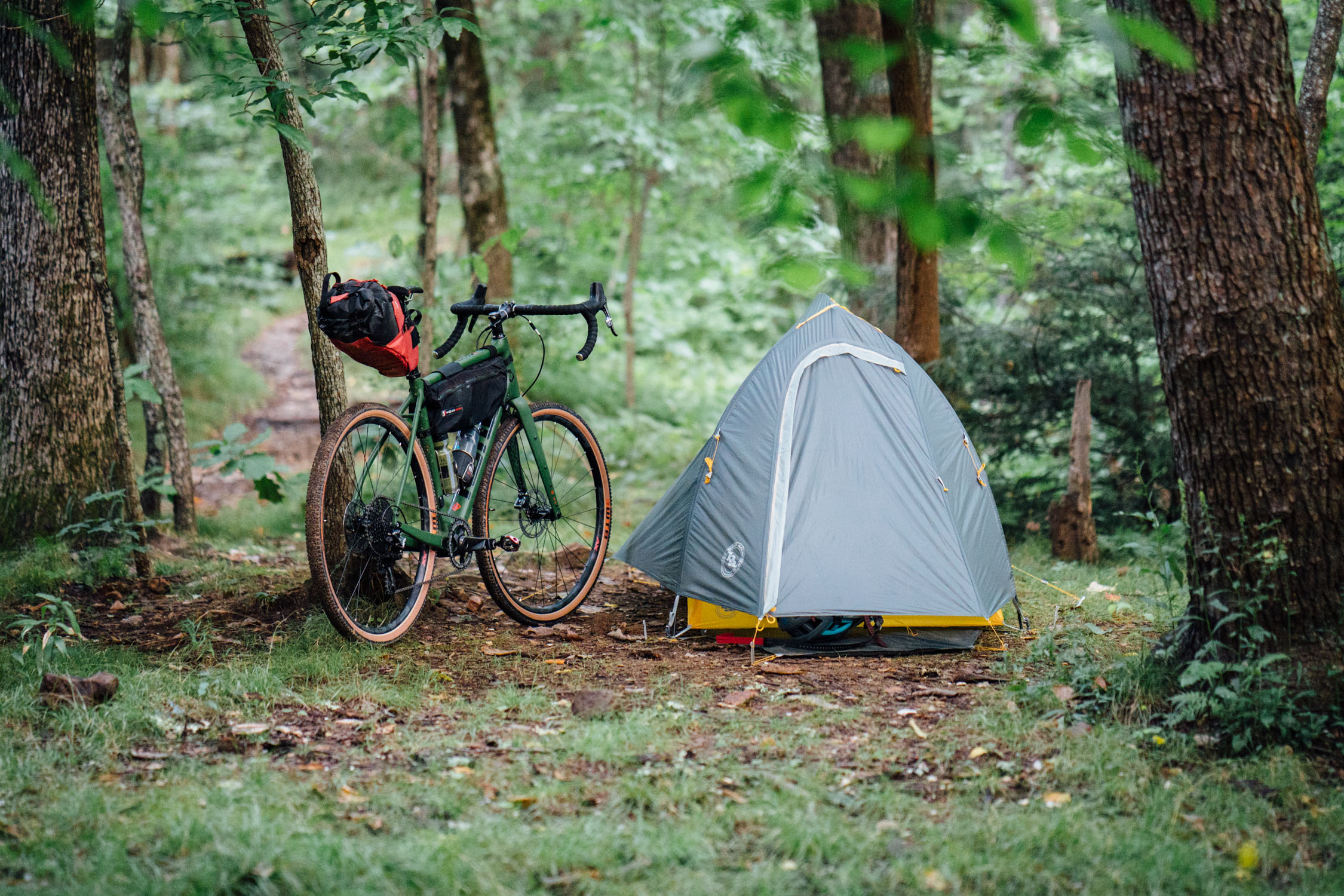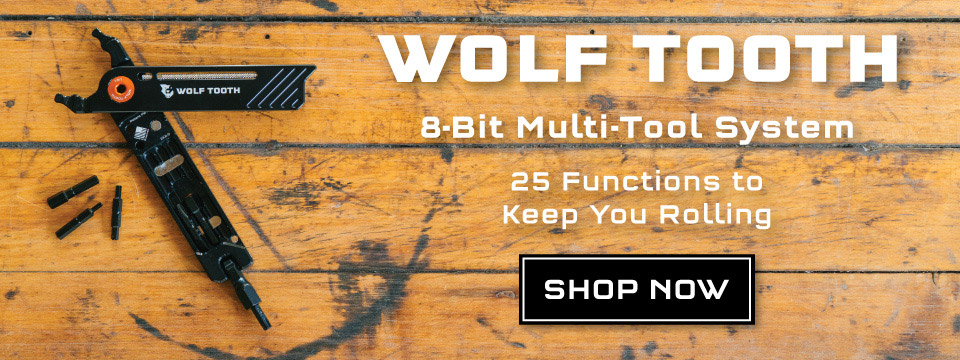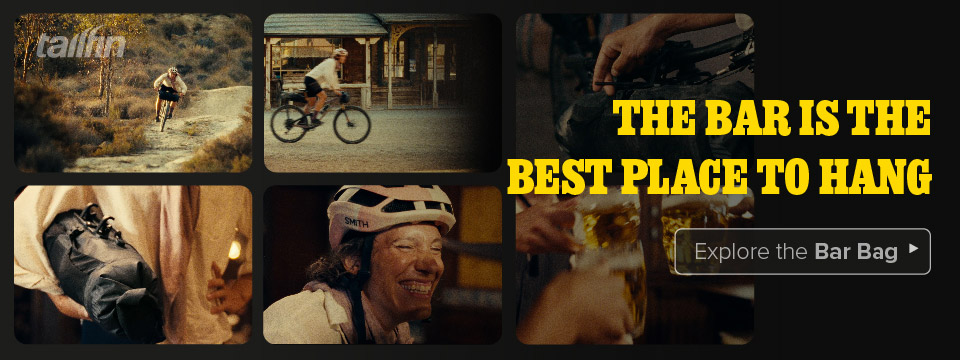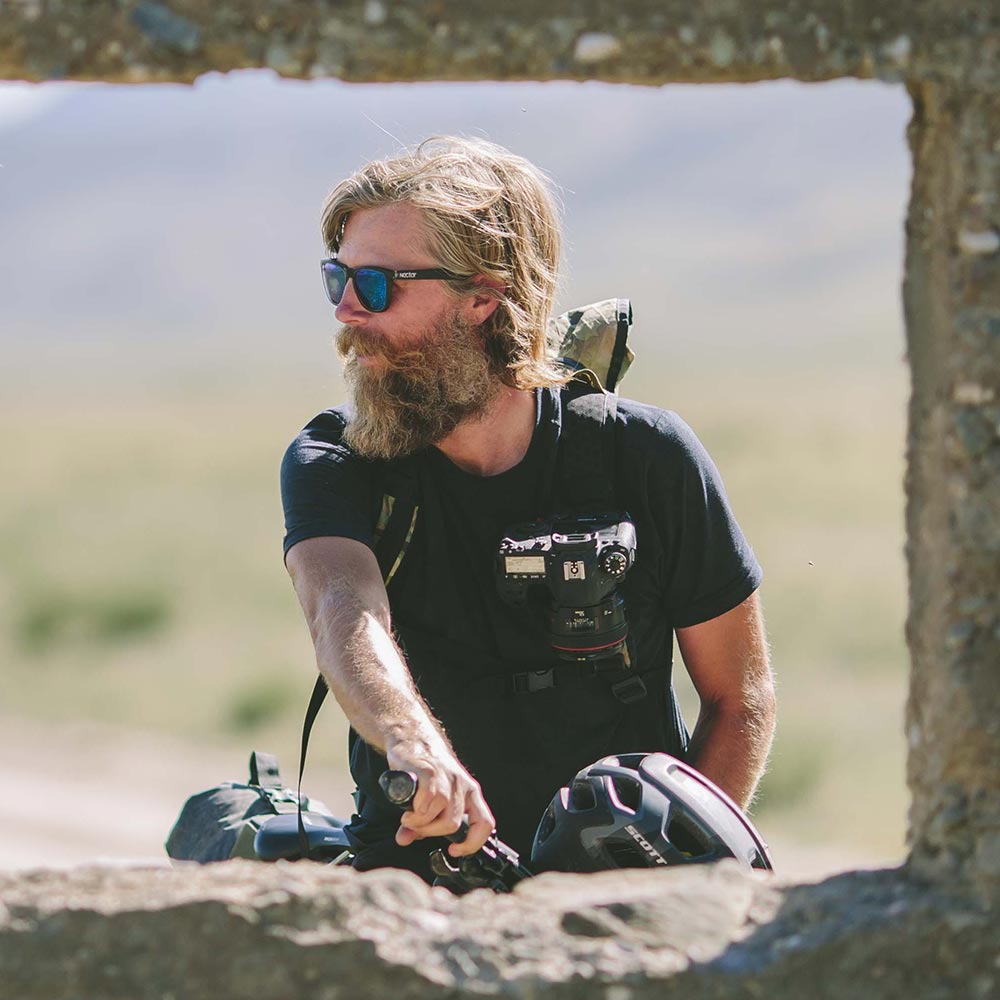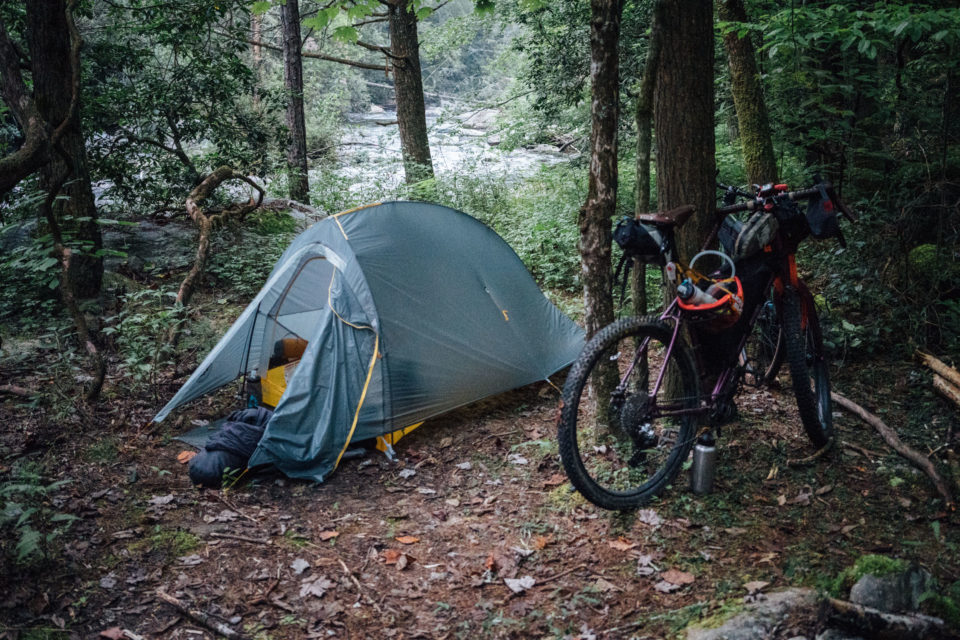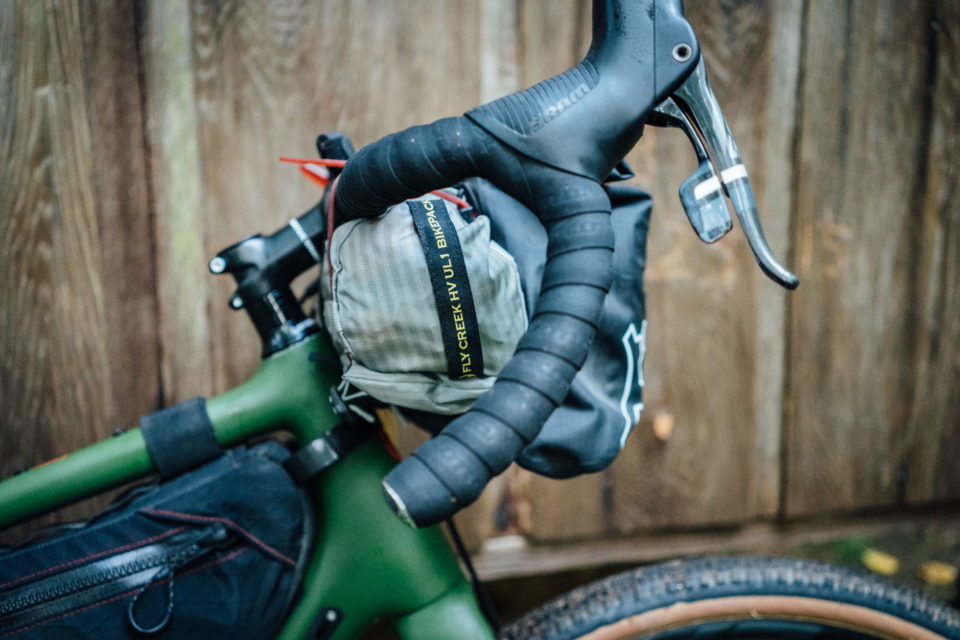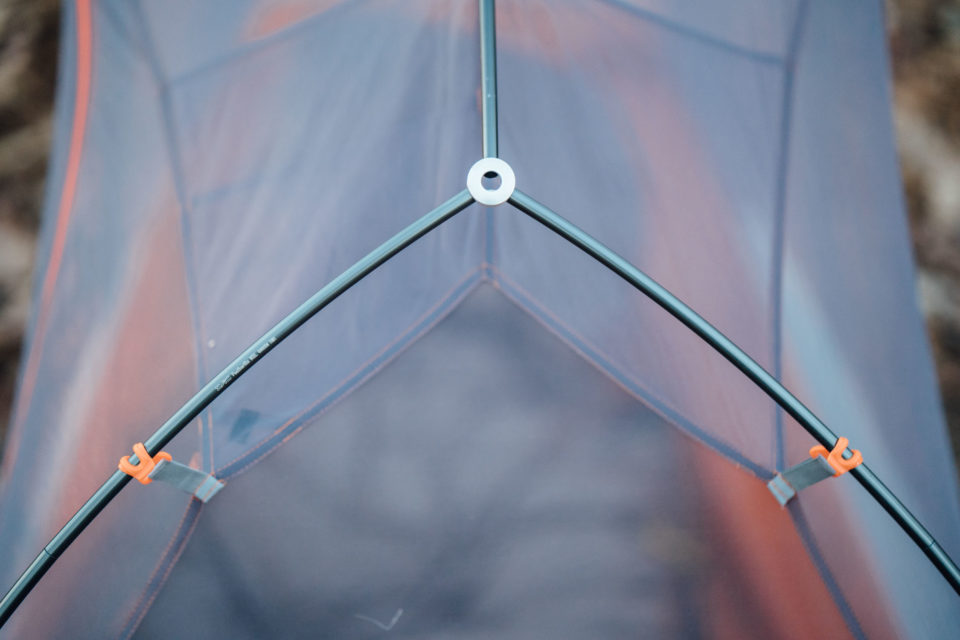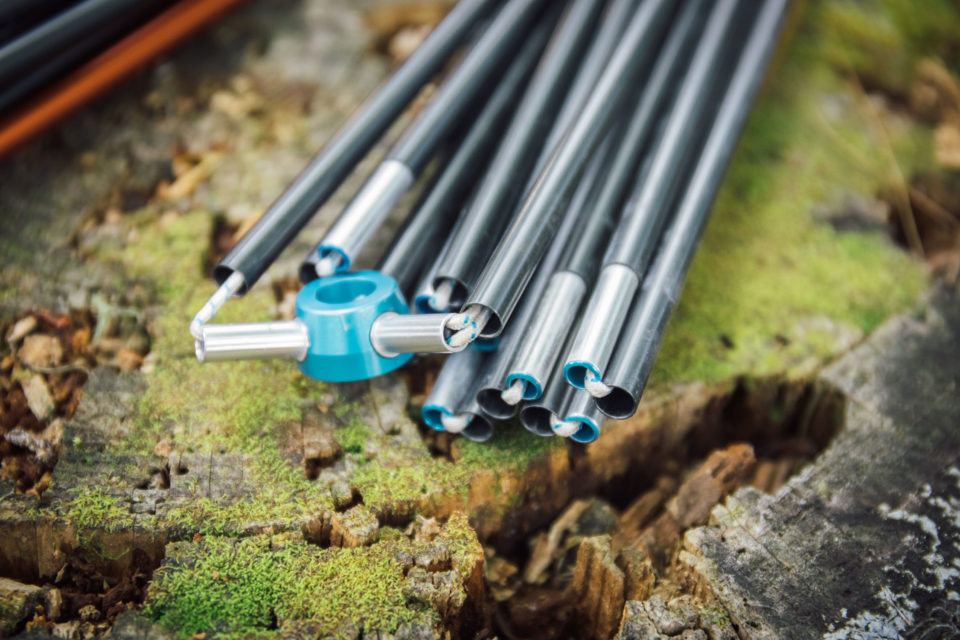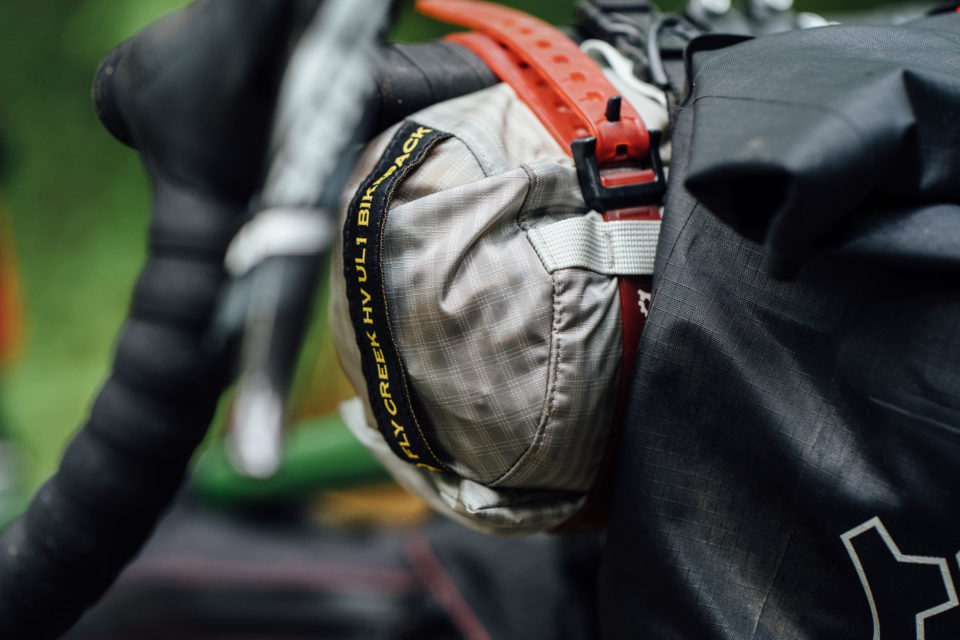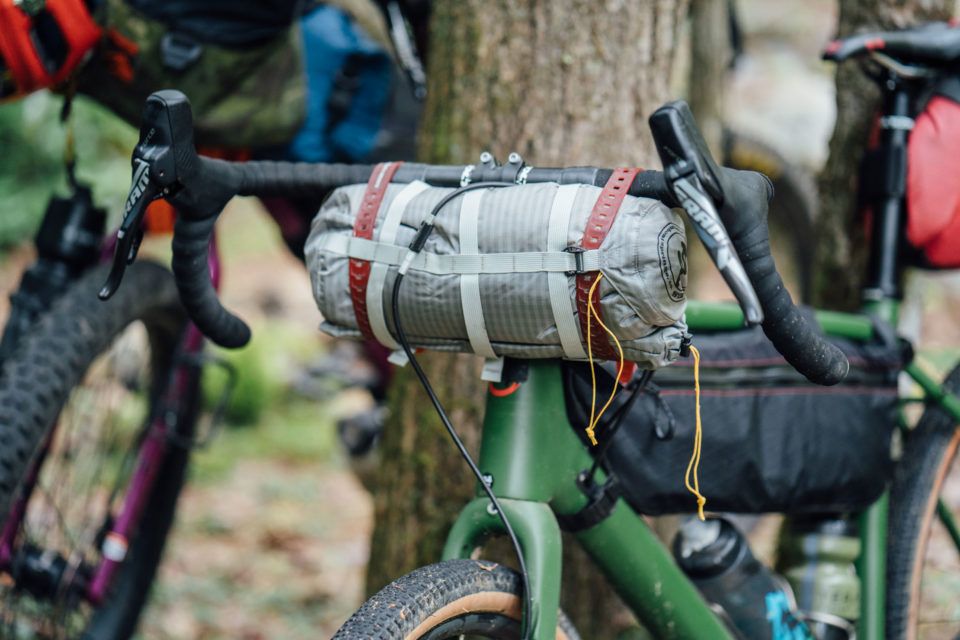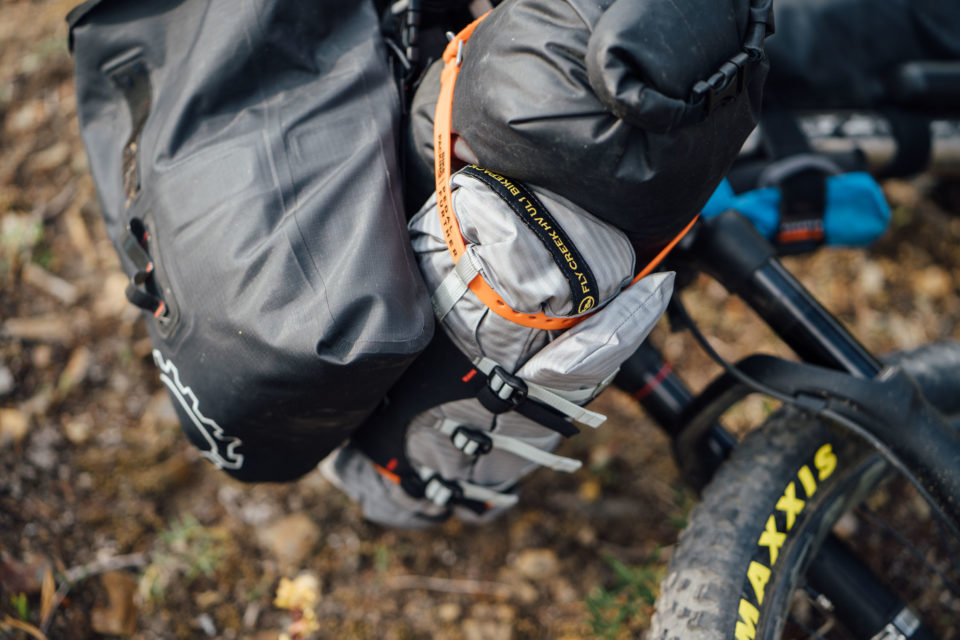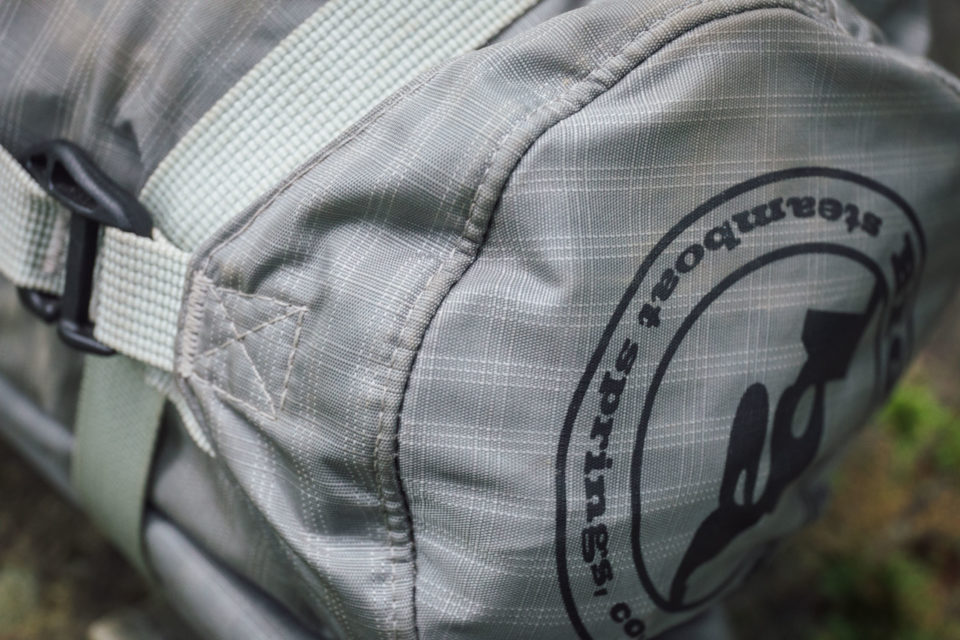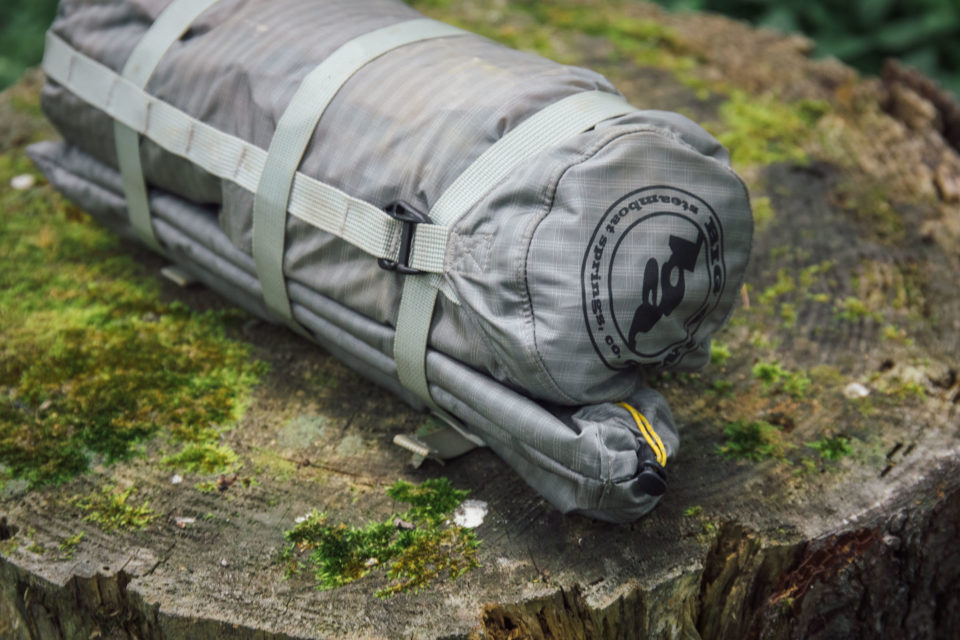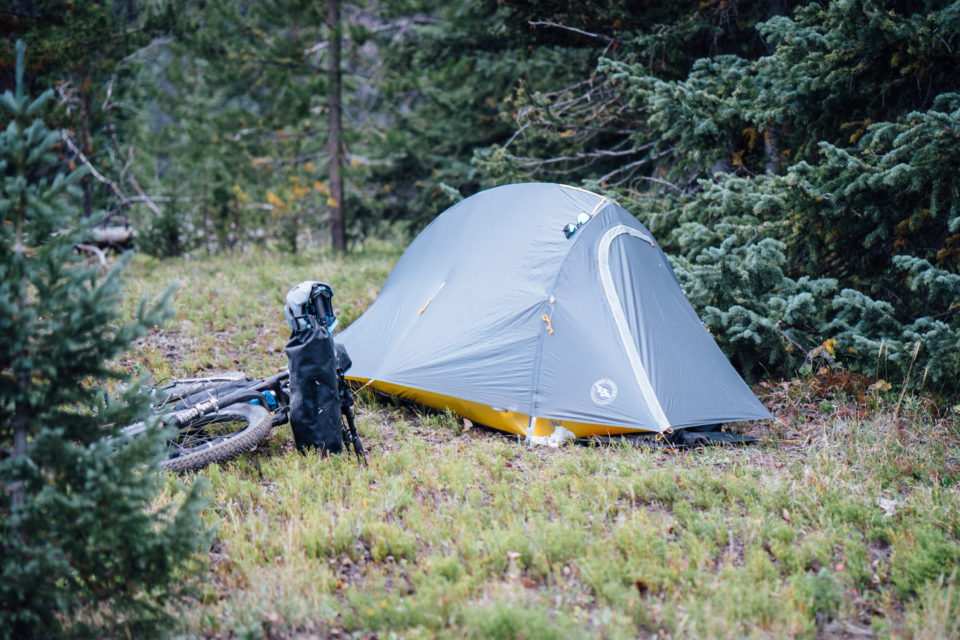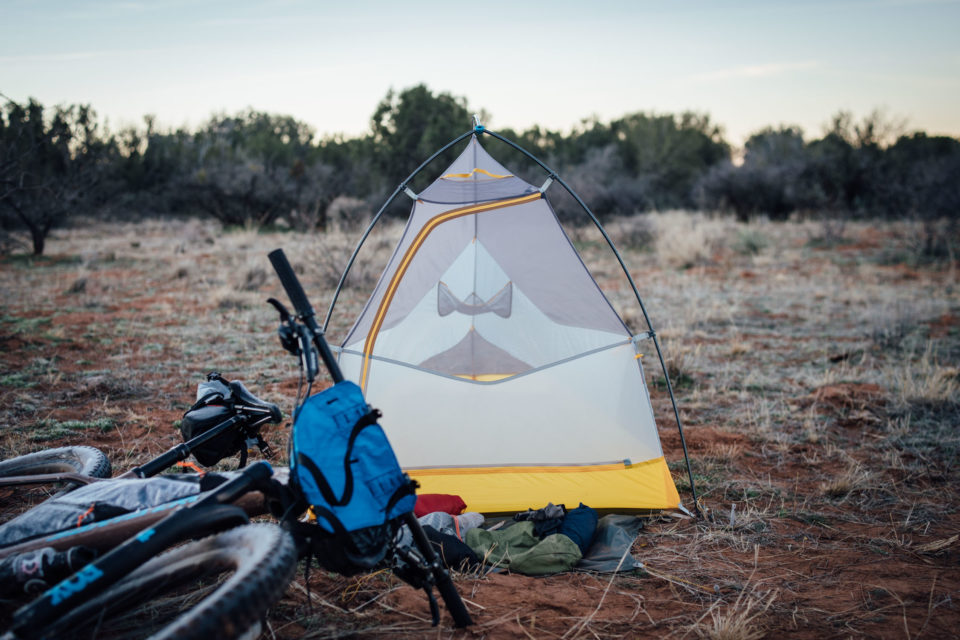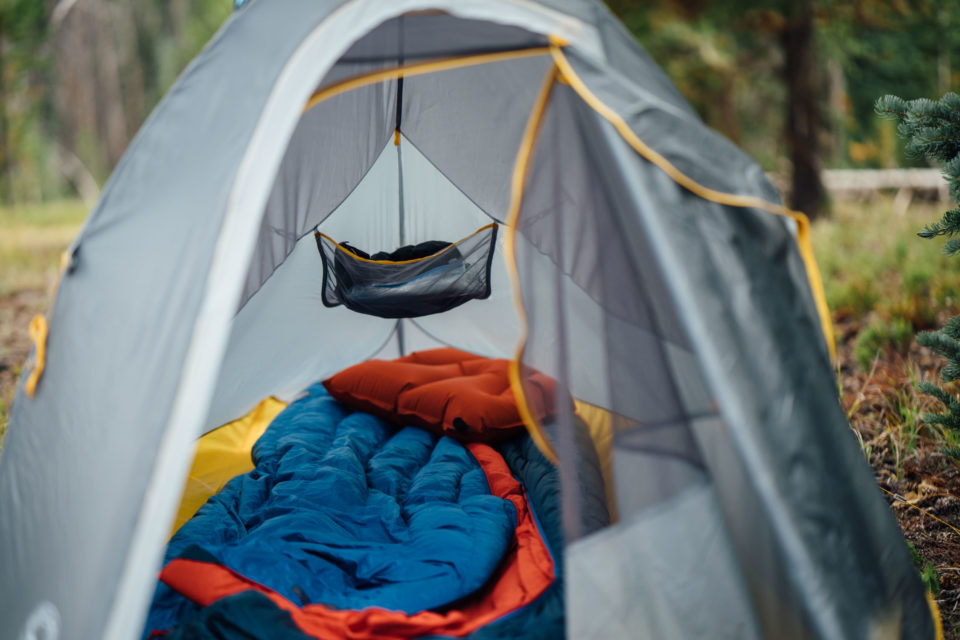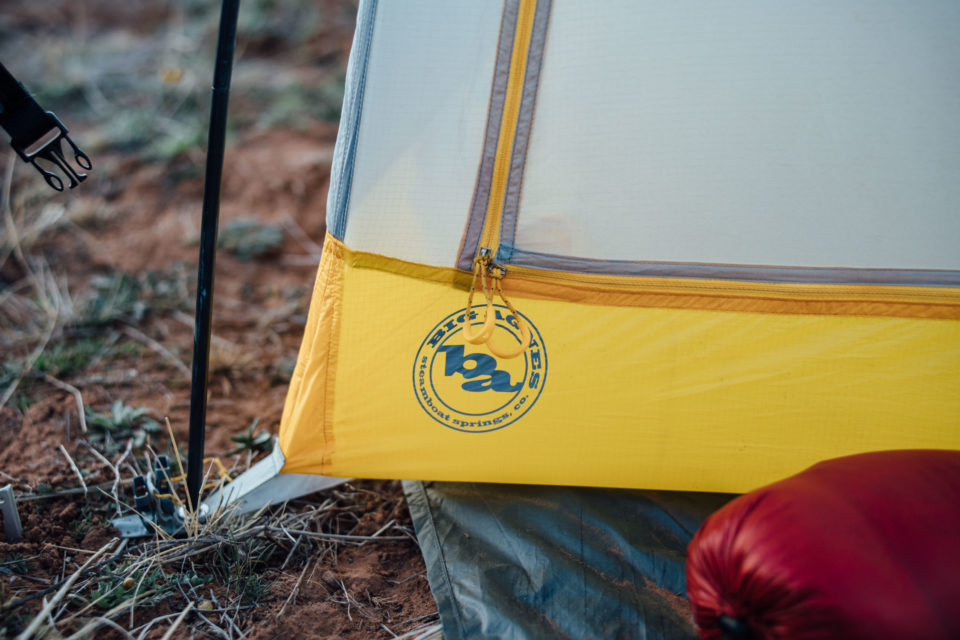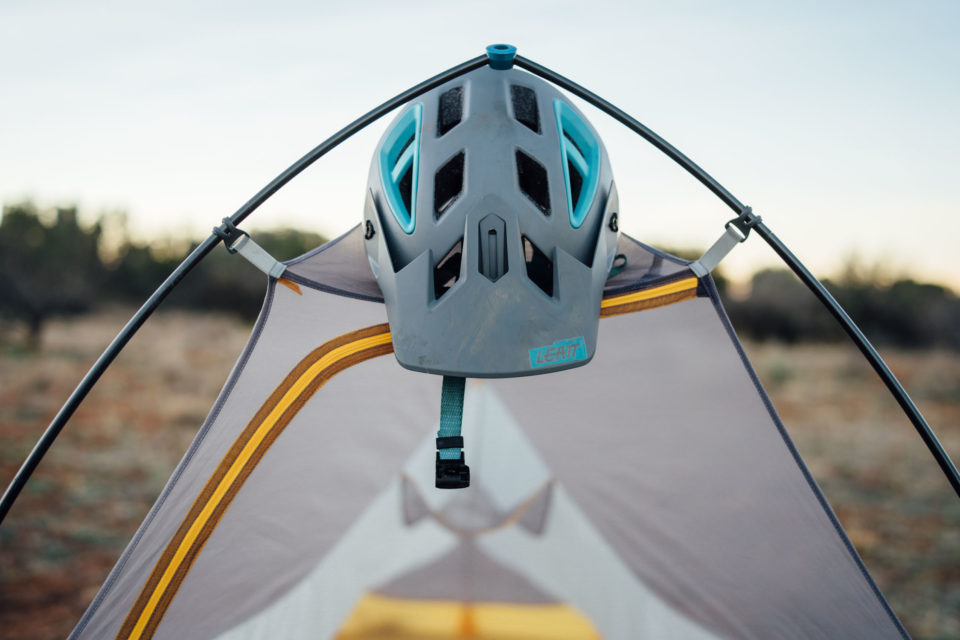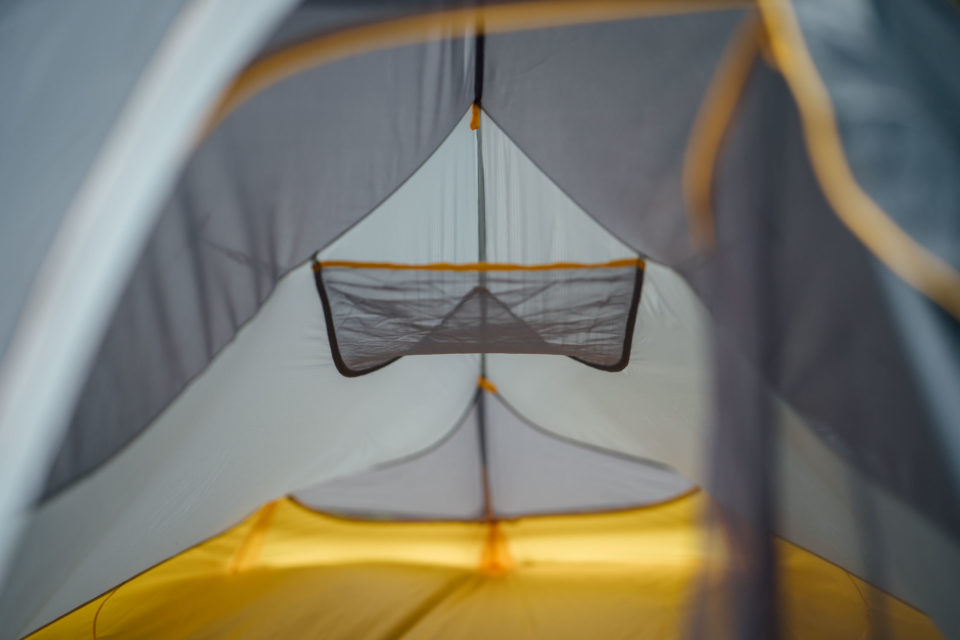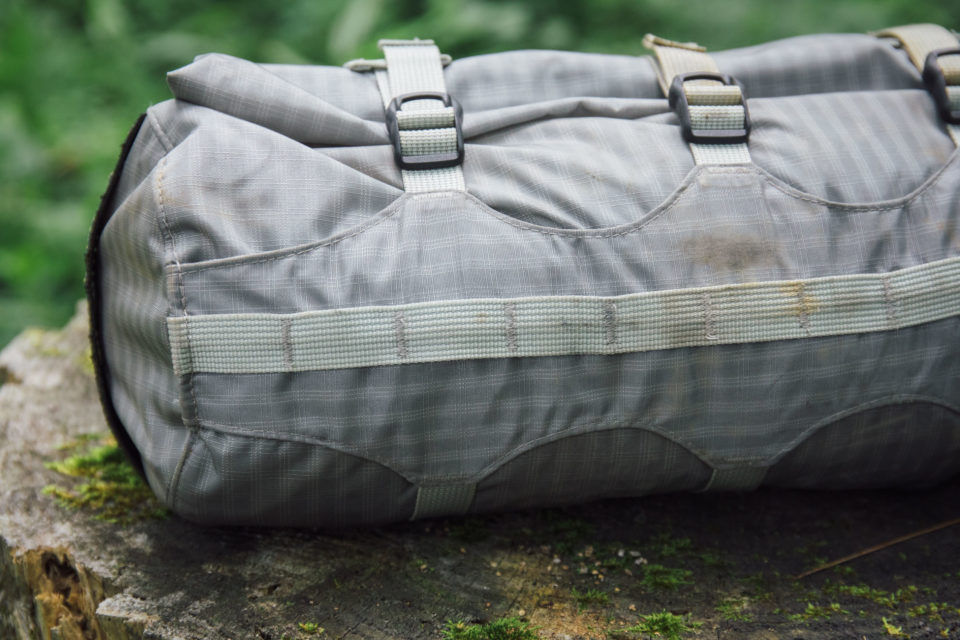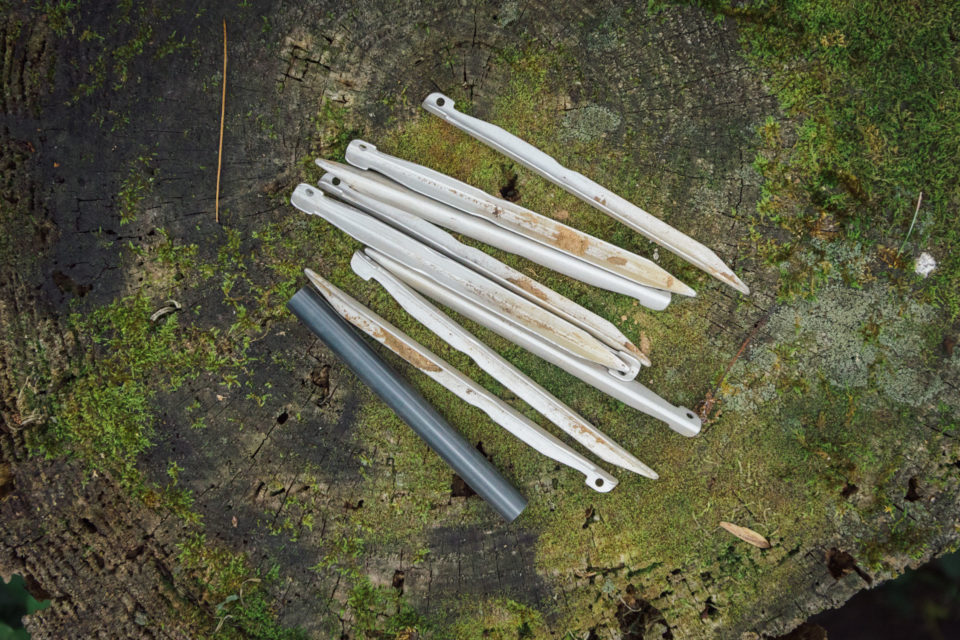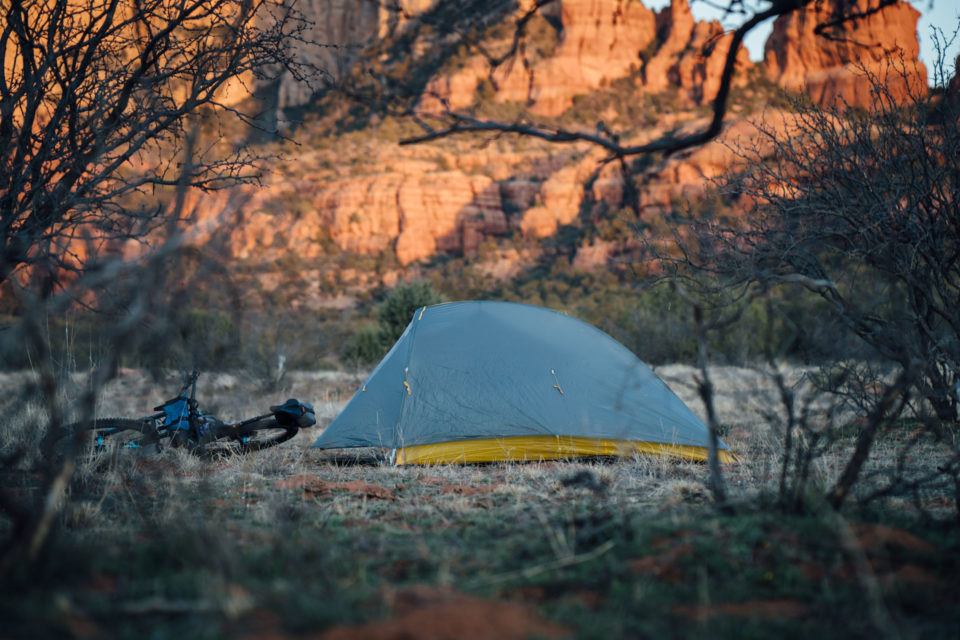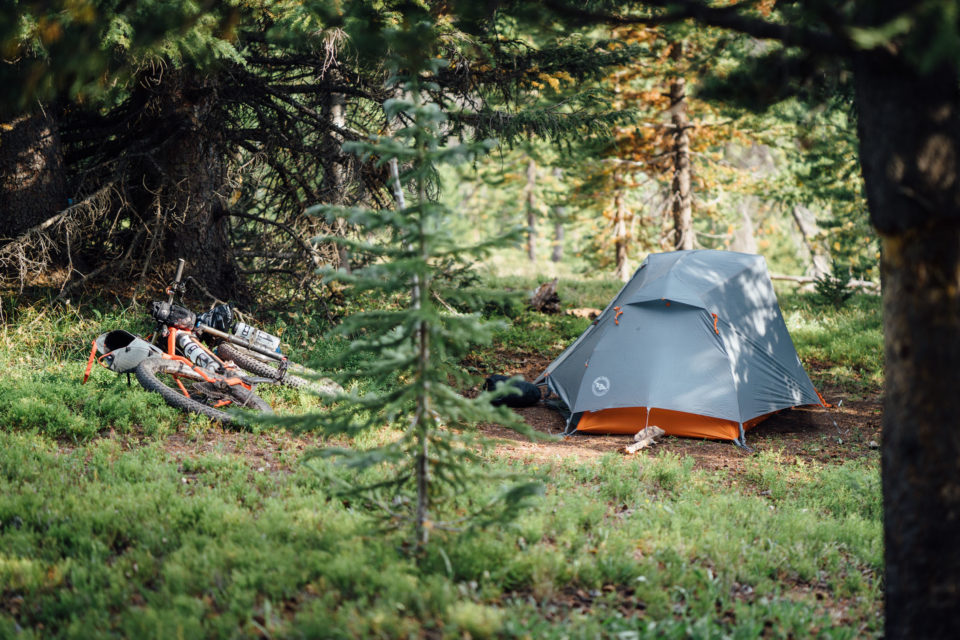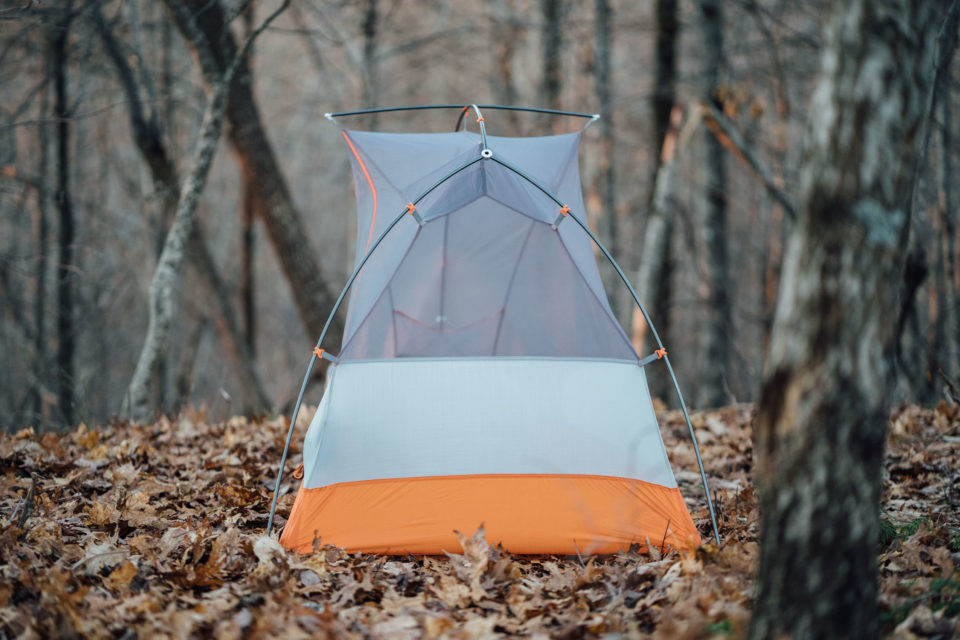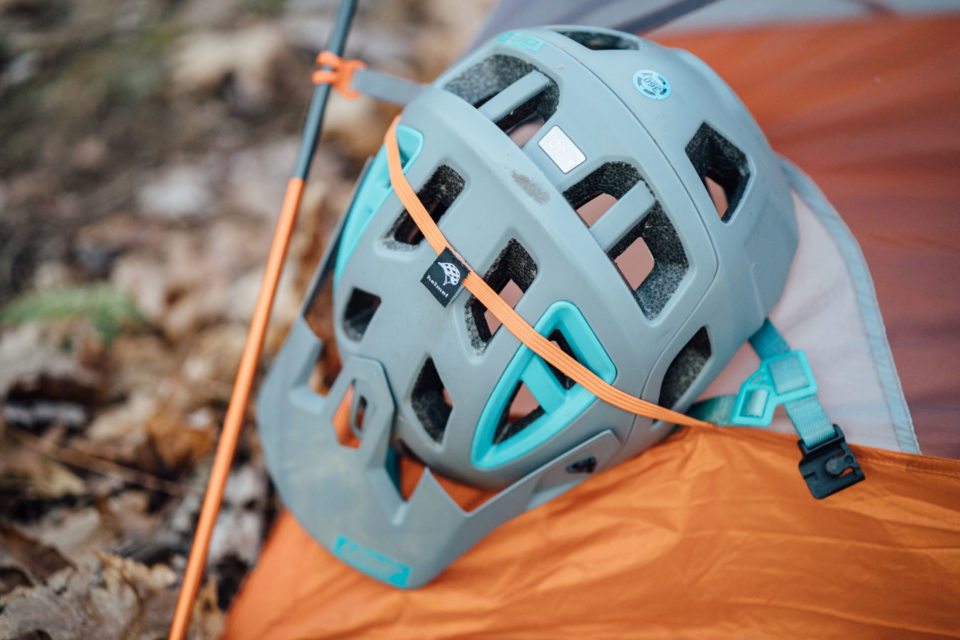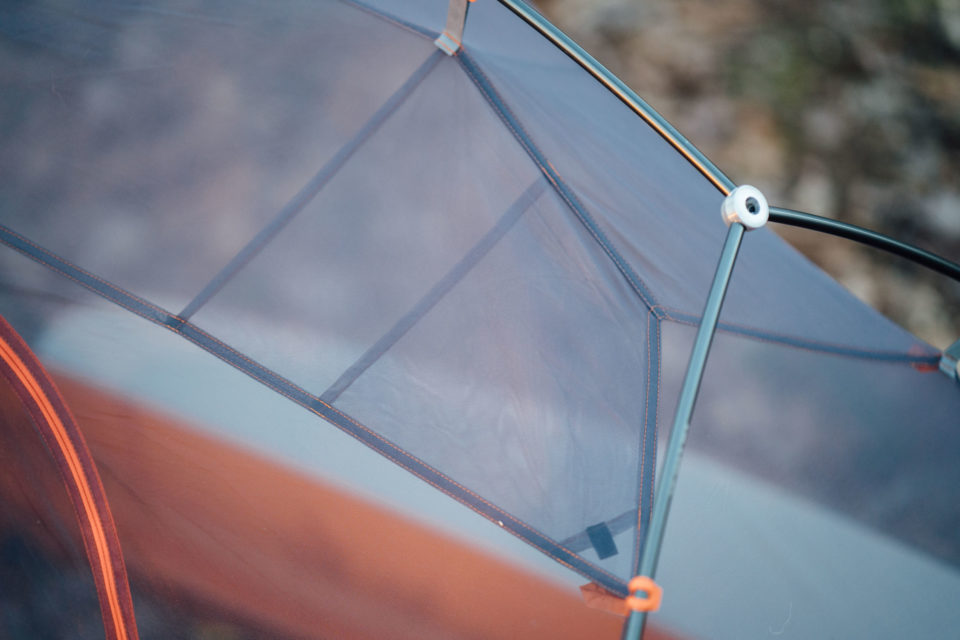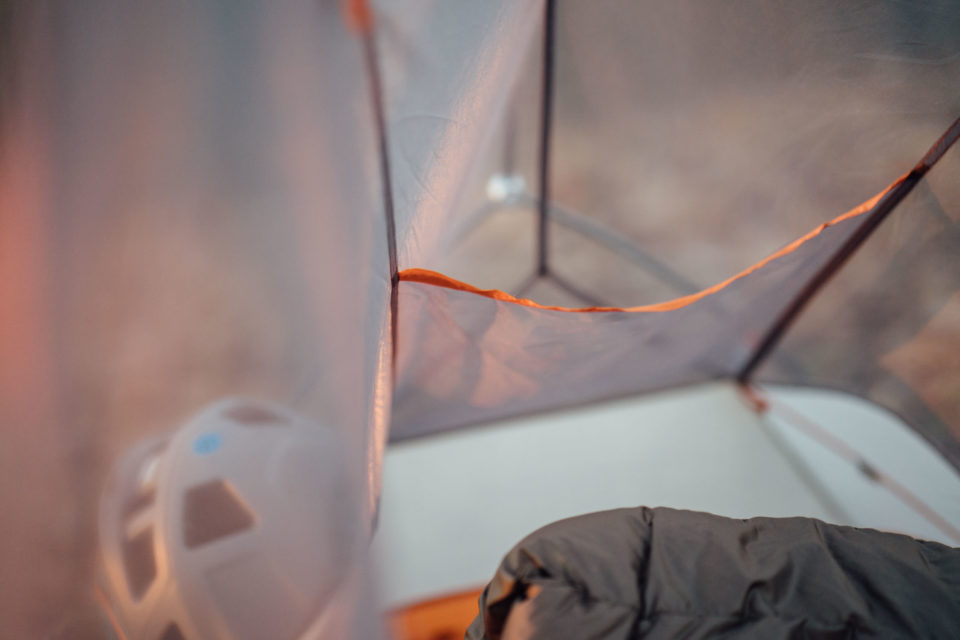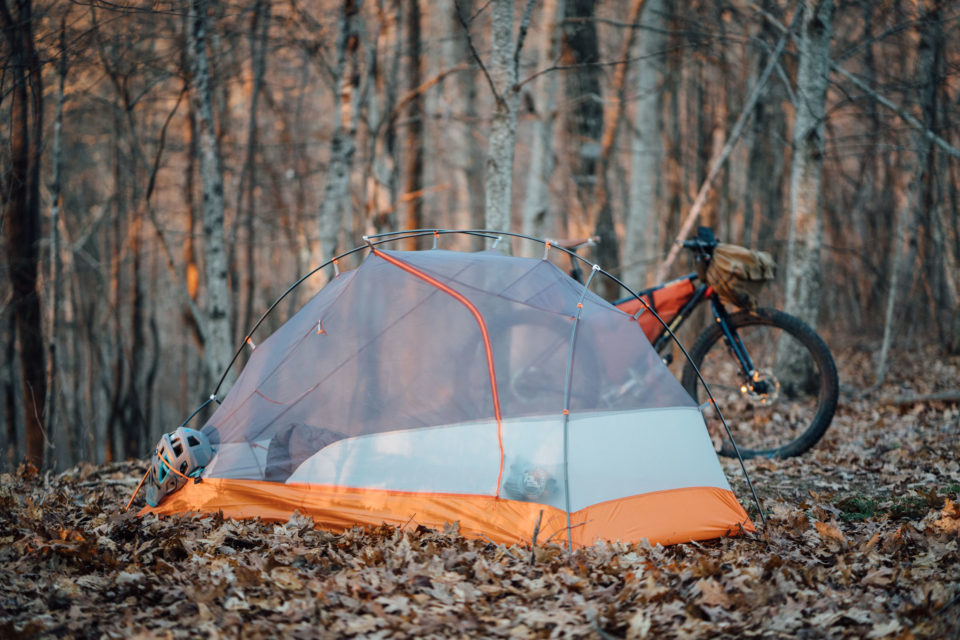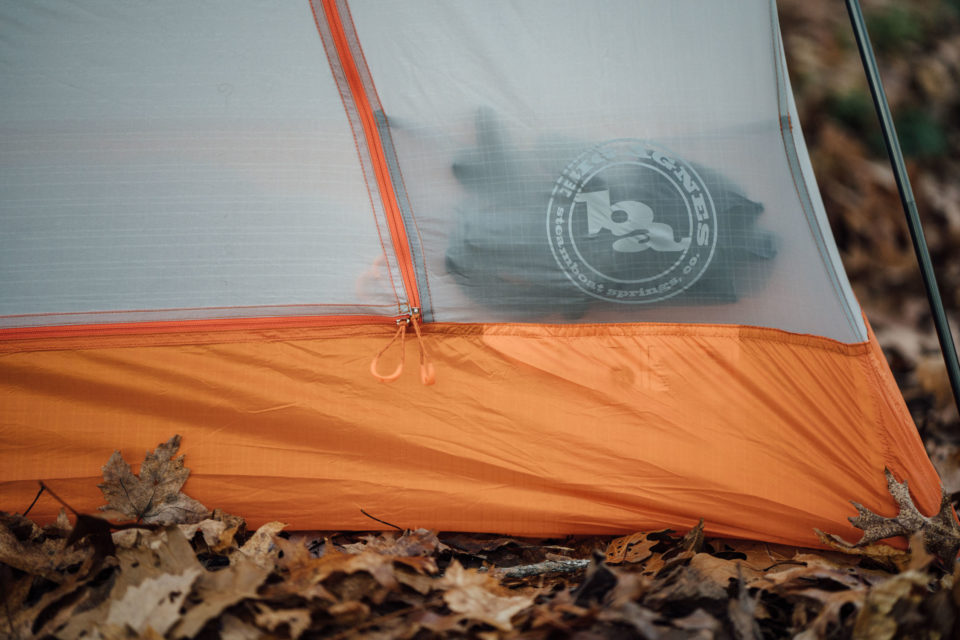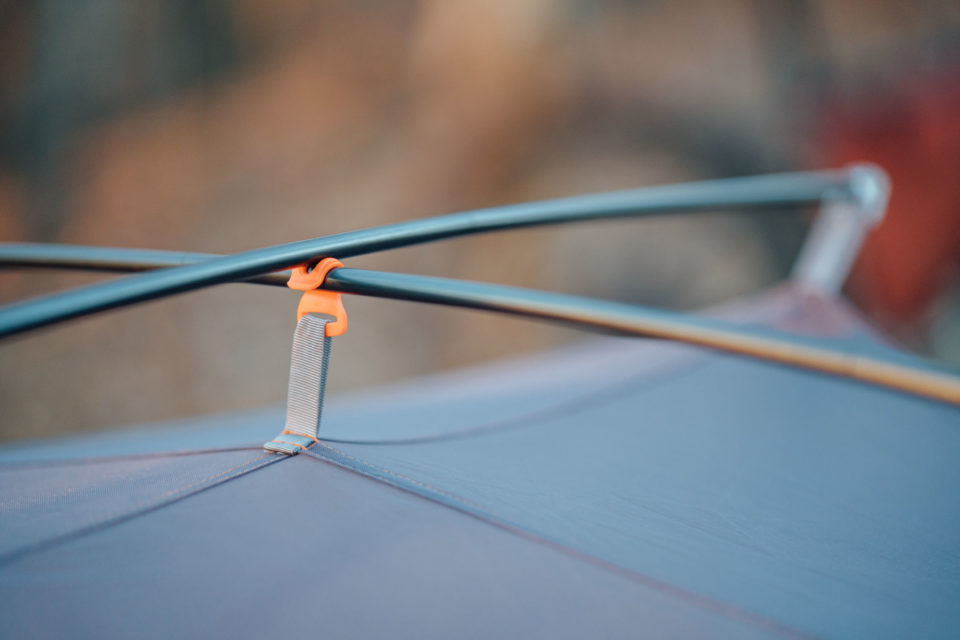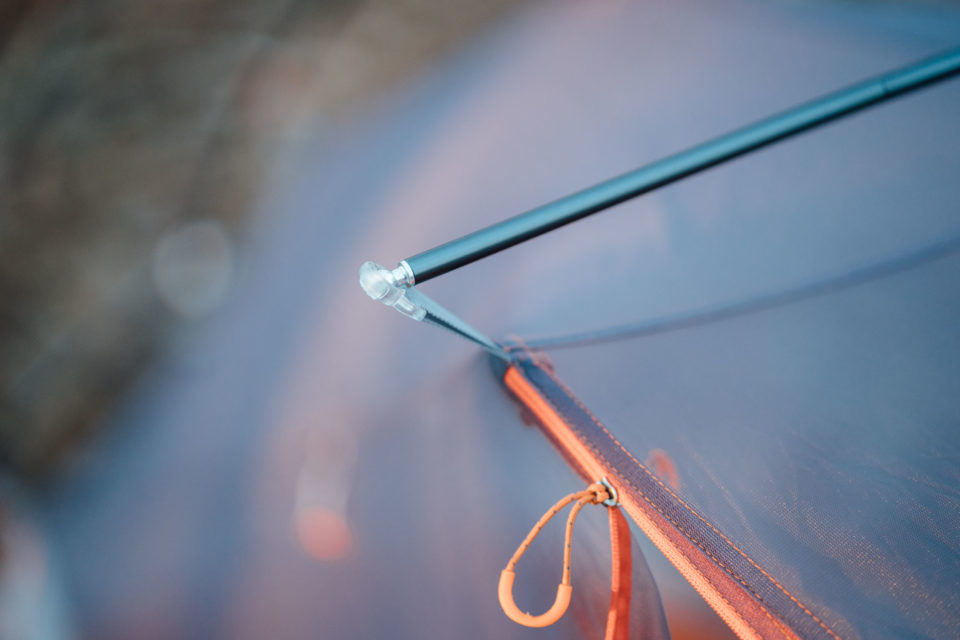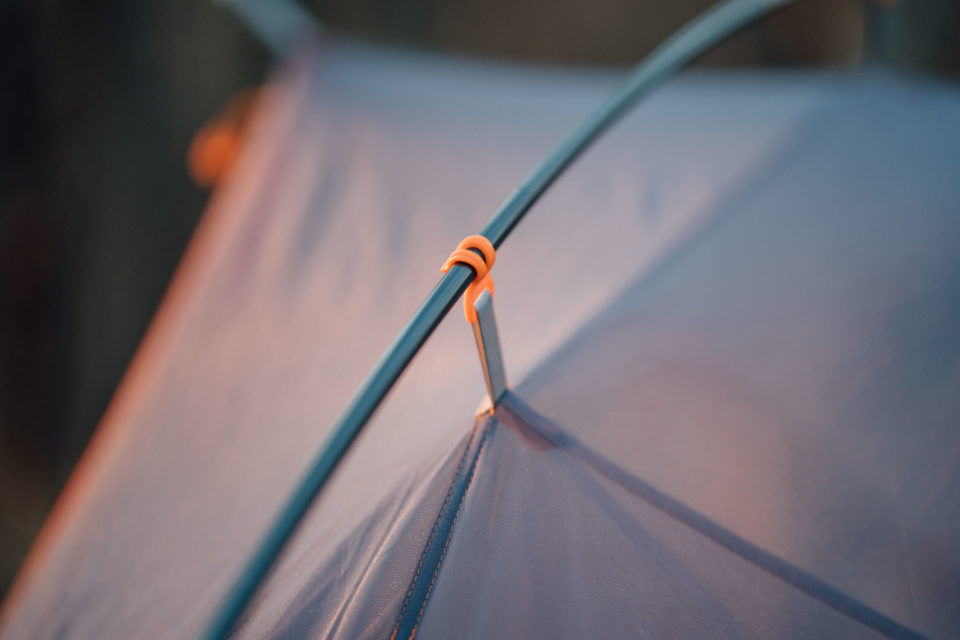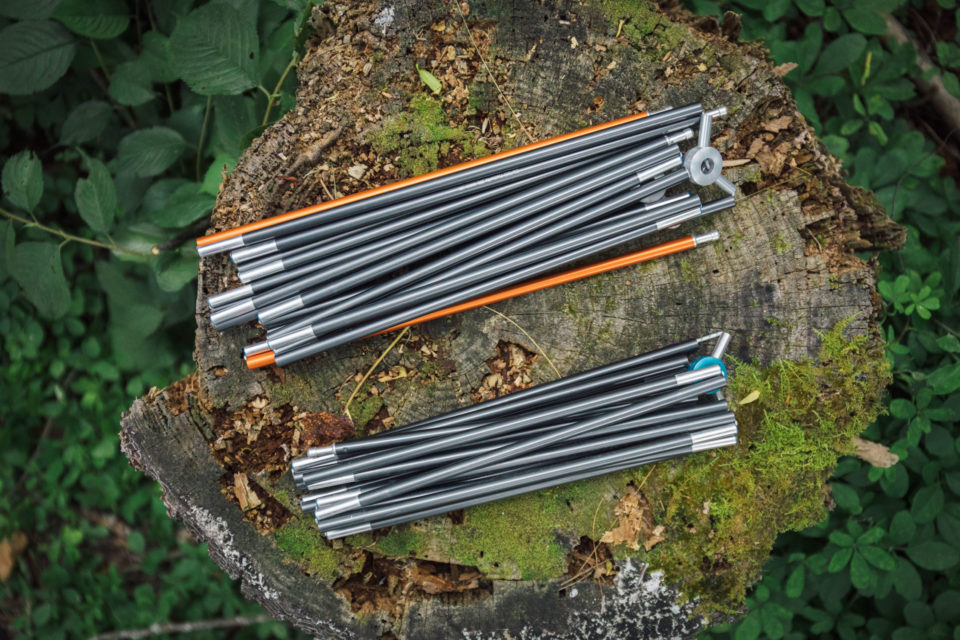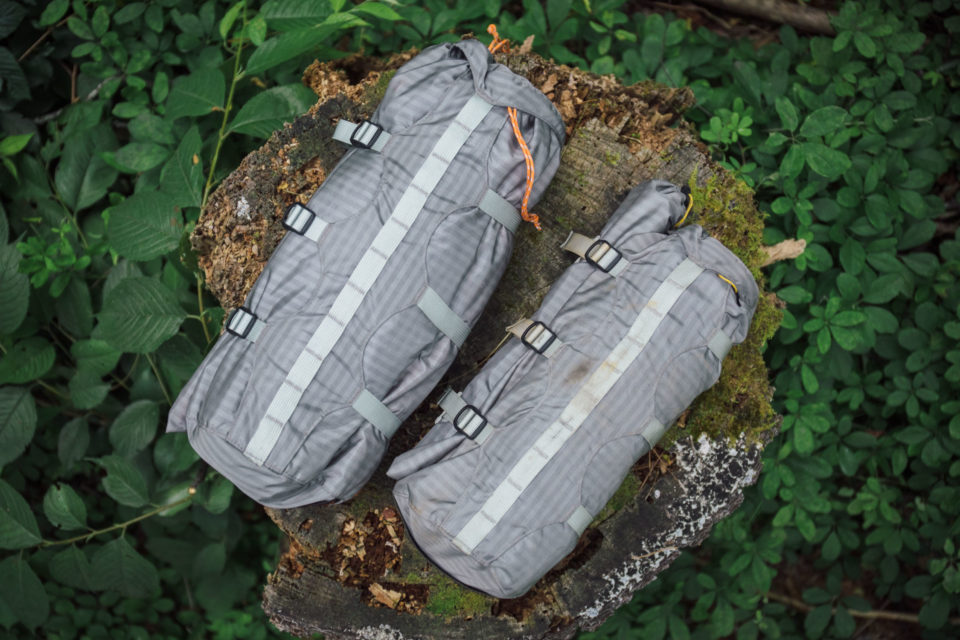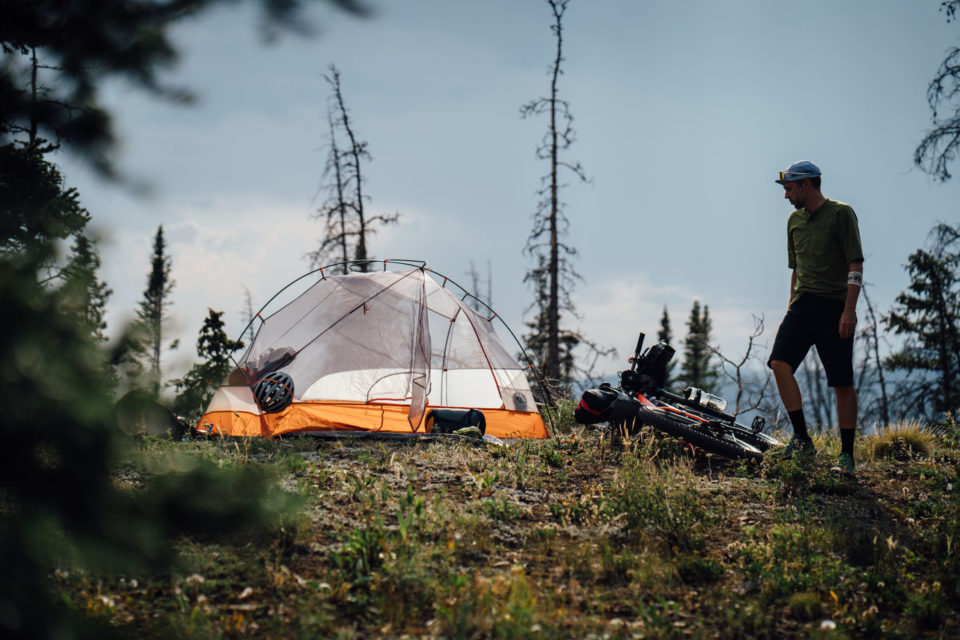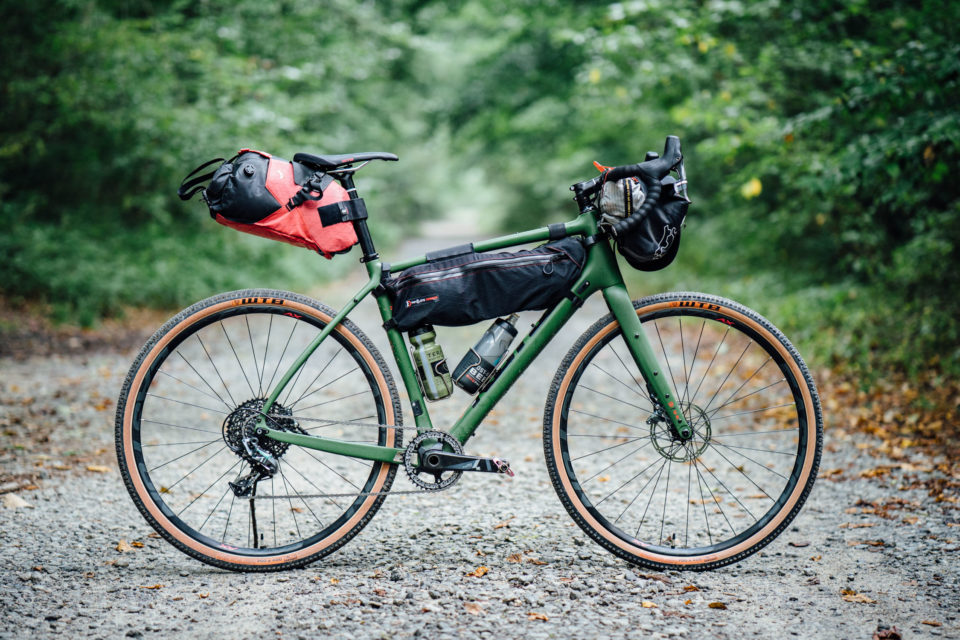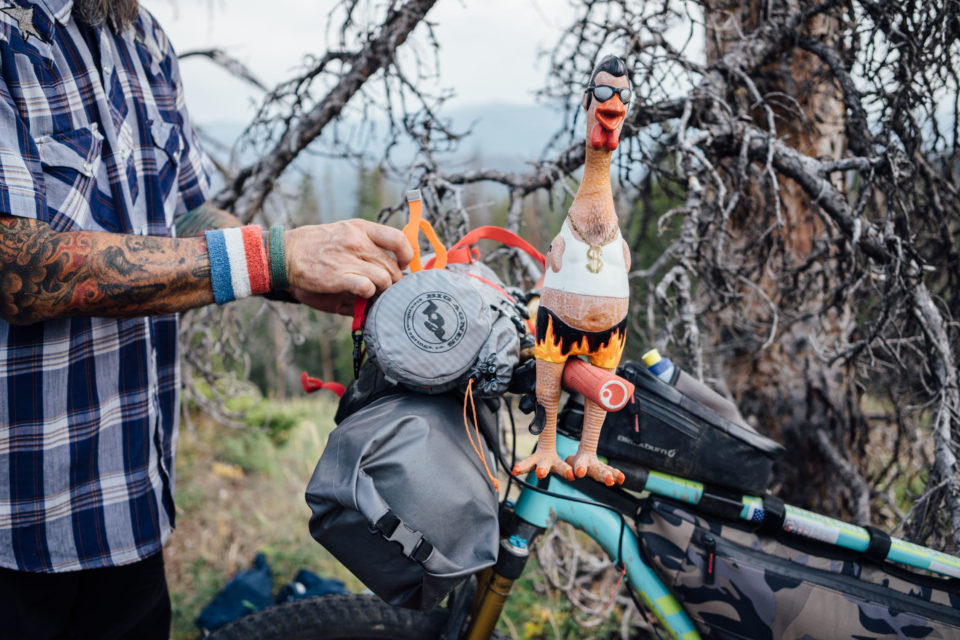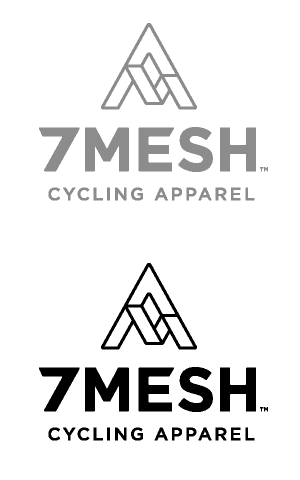Big Agnes 1P Bikepack Tents: Fly Creek vs. Copper Spur
We’ve been testing the Copper Spur HV UL1 Bikepack and Fly Creek HV UL1 Bikepack, Big Agnes’ two bikepacking-specific, 1-person tents that were announced last summer. Nearly a year in, here are our thoughts on each, plus a detailed comparison…
PUBLISHED Jun 18, 2019
Last summer, we were excited to see Steamboat Springs, Colorado-based Big Agnes introduce a new line of bike-travel-specific tents at the Outdoor Retailer industry trade show in Denver. This lineup, appropriately titled “Bikepack,” includes bike-camping versions of four popular Big Agnes ultralight (UL), high-volume (HV) tents: Fly Creek HV UL1, Fly Creek HV UL2, Copper Spur HV UL1, and Copper Spur HV UL2. In essence, Big Agnes took its four best and lightest backpacking tents and made them more bikepacking-friendly. We had a chance to test the 1-person versions over the last year. Read on for an overview and impressions of each, followed by a comparison between the two…
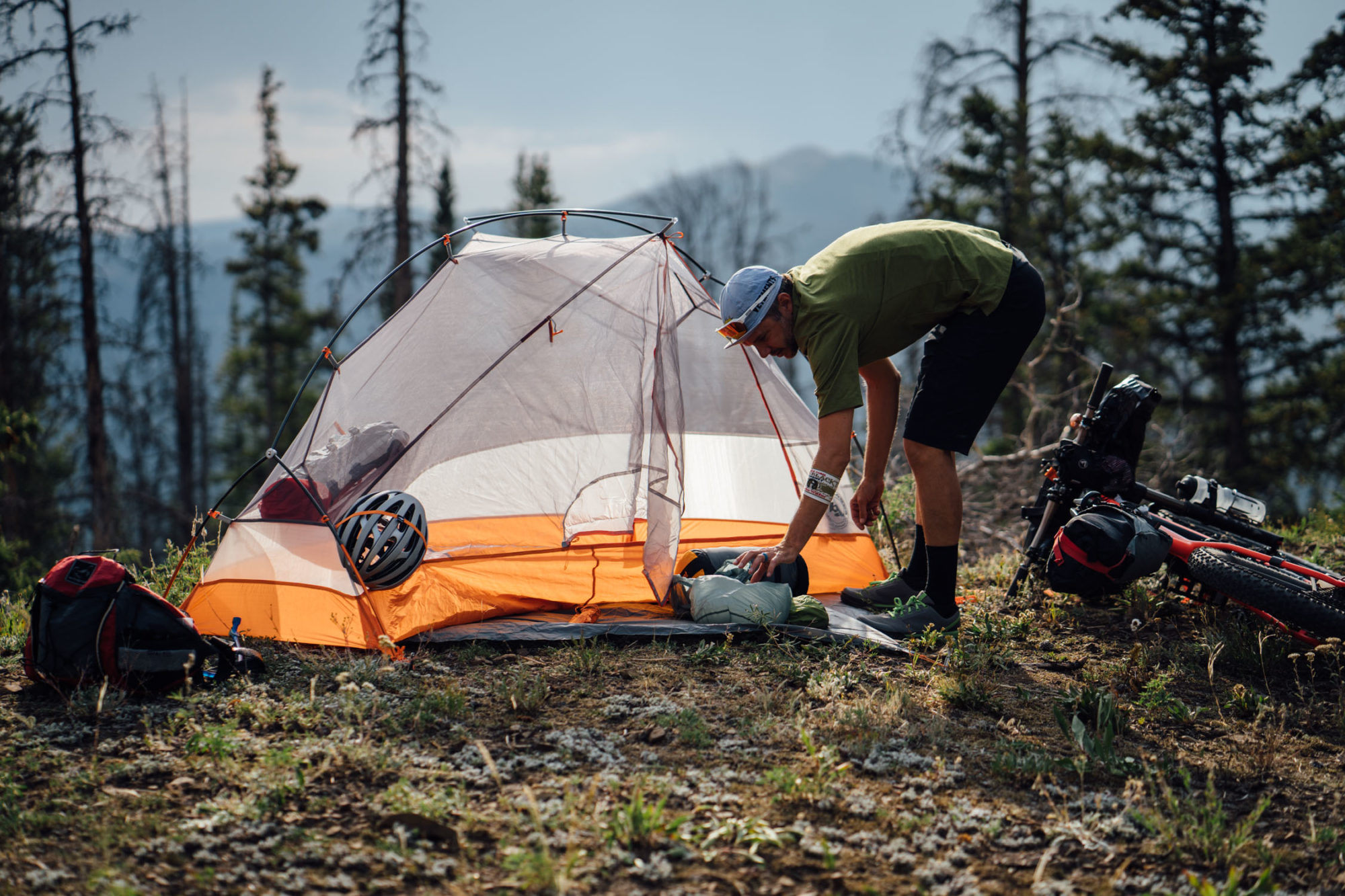
Bikepack vs Backpack
In case you missed our original dispatch, the full Big Agnes Bikepack line has several interesting innovations, including the re-engineered Shortstik Poleset. These new aluminum DAC tent poles have a 12-13″ (30.5cm) segment length, enabling them to fit between the shifters on a drop handlebar or inside a frame bag or small panniers, or to simply save room in any bag. It’s worth noting that both the Copper Spur and Fly Creek Bikepack models come with DAC’s new latest “green” poles, which are anodized without the chemical polishing stage, thus eliminating two hazardous chemicals.
For the Bikepack line, Big Agnes 86ed the typical sil-nylon tent bag. Instead, each Bikepack tent comes in a bikepacking-ready compression sack that’s built to attach to the handlebars and offer additional attachment options with an integrated daisy chain system. The poles are in their own bag made from the same burly material and lash onto the main bag with integrated compression straps. I found that the best way to attach it to the bars is with two Voile straps, or two Revelate washboard straps as shown here. It makes a pretty solid system with that method, which can be supplemented with more straps or an accessory pocket. In addition, you can also strap it to another handlebar bag, expanding the front load (as shown in the third image below).
Big Agnes claims the compression sack is designed to withstand the rigors of trail travel, which I would back after using it on several trips; it’s definitely much more rugged than a typical tent bag. The compression stuff sack isn’t completely waterproof like many modern handlebar rolls, but it does shed water pretty well.
Otherwise, all of the HV UL Bikepack tents have the same floorspace, living area, and vestibule square footage as the ultralight HV originals. And as with all Big Agnes tents, the fly and floor of each Bikepack tent are made from a silicone treated rip-stop nylon with a waterproof polyurethane coating. All seams are taped with solvent-free waterproof tape and the pole clips are made of an “ultralight” plastic.
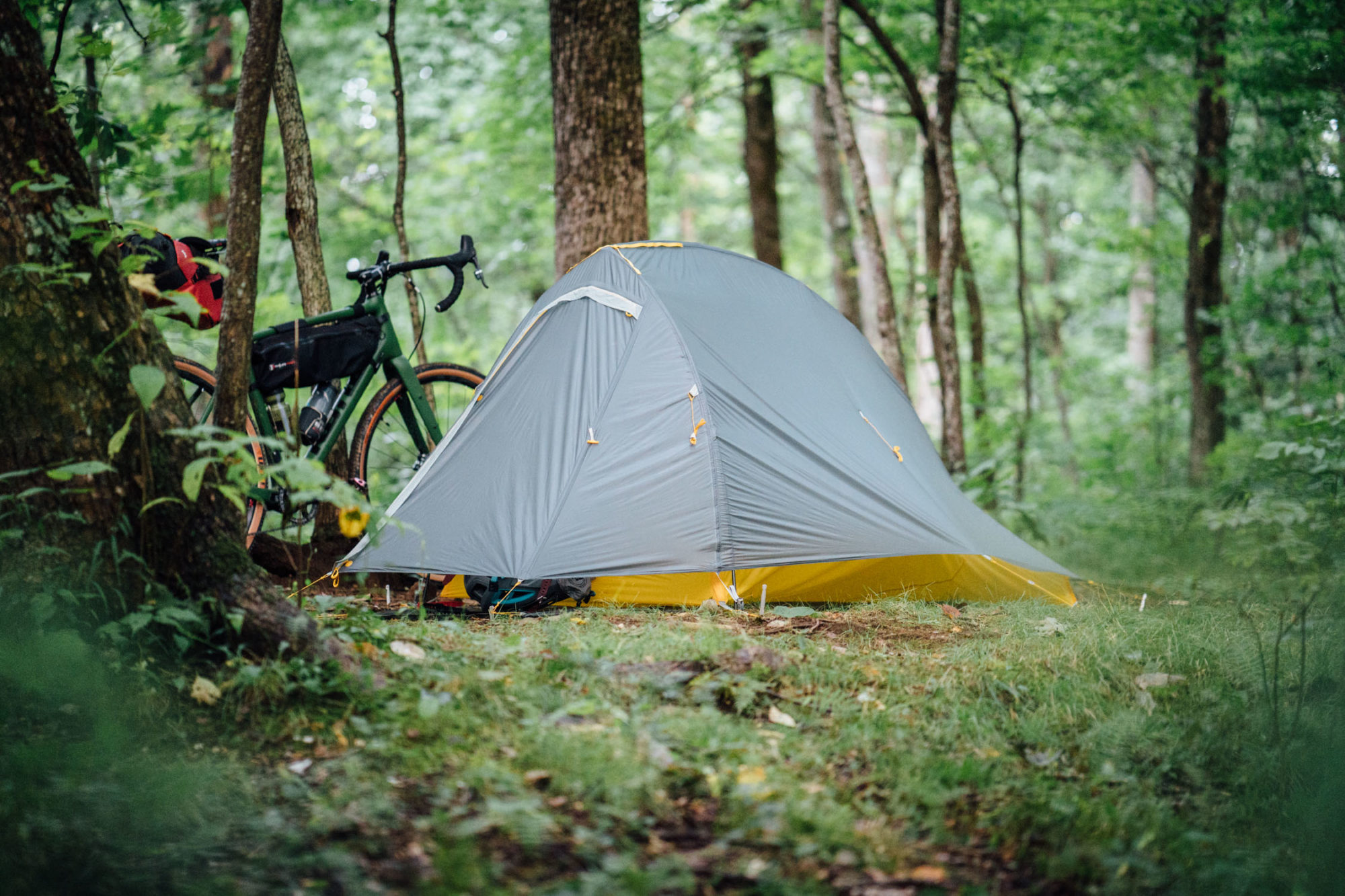
FLY CREEK HV UL1 BIKEPACK
Fly Creek is Big Agnes’ most popular tent line and one of the lightest designs in their entire catalog. The Fly Creek tents are recognizable for their simple Y-shaped pole configuration (a single series of press-fit pole segments that come together in a “Y” configuration). This skeleton supports a non-freestanding (mostly mesh) inner shelter body that’s staked at its four corners. The single door/vestibule at the front of the tent is formed by the second layer rainfly which is clipped at the end of each Y point and staked at the four corners; the two vestibule corners are also staked, forming a six-sided trapezoidal shape.
Over the years, I’ve tested the Fly Creek UL3 in Africa, Asia, Eastern and Western Europe, and the US. I’ve also spent a considerable amount of time in the Fly Creek UL 1 and HV UL1 on many solo missions—you can read the review/comparison between those two here.
As a quick recap, Big Agnes revamped its Fly Creek line in 2016 with “HV” upgrades that offered steeper walls and more usable interior volume, among other improvements. In my experience, each tent in the Fly Creek series is an excellent, lightweight option for bikepacking; I’ve recommended both the HV UL1 and UL3 to countless people over the years. In addition, Lucas has been using the Fly Creek UL2 since 2013 and feels the same way.
The latest iteration of the 1-person Fly Creek, the HV UL1 “Bikepack” is quite similar to the latest HV model, with several subtle changes and additions. Here’s what’s changed:
What’s Changed?
In addition to shorter tentpole segments and a specialized compression sack, the Fly Creek HV UL1 Bikepack has a couple other bike-friendly features, including a helmet sleeve under the fly at the top, which honestly doesn’t really do anything for me. I used it for a photograph, but otherwise, I’ve been contently placing my helmet on the ground in the tent vestibule for years, and don’t see the need to change that. However, saving a little vestibule storage could be nice.
Big Agnes also added daisy chains to the ridge of the Fly Creek for lashing on clothes or other gear. This has proven to be quite handy on several occasions for drying a jersey or chamois in the sun. Another interesting addition for gear storage is the 3D-Shelf, an ever so slightly ramped mesh ledge toward the knee area in the tent that’s just large enough to stow several items of clothing. I’ve found myself tossing my full set of riding clothes and hat in it during the night—shorts, jersey, chamois, and socks—to declutter the limited floor space.
Big Agnes also claims the Bikepack version has a larger vestibule, but I couldn’t discern much difference between the older HV and the Bikepack version; Big Agnes may have been pointing out the difference from the original non-HV Fly Creek UL1 in its marketing. Note they also upgraded to a larger footprint that creates a vestibule floor. Personally, I almost always ditch the footprint, although I used it once to see what it was all about. It actually came in handy as a place to sit and prepare coffee while avoiding the damp ground one morning.
The other upgrade Big Agnes made to both the Fly Creek and Copper Spur is a significant one, which I both like and dislike at the same time. Instead of having a single zipper that arcs at the lower part of the entry door, they made it a hard corner where two zippers converge into a zipper garage. I understand why they did this, as there have been several reports of zipper failures and this takes the stress off the single arced zipper. That said, in my many miles and years of use of the UL3 and UL1, I never had an issue. I suppose I appreciate this update, although it feels a little foreign and cumbersome to me. Perhaps I’m just set in my ways.
Impressions
Generally speaking, I think most of the updates are pretty good on the Bikepack version of the Fly Creek HV UL1. There are a couple specs that might give some people pause, though. The trail weight (tent body, poles, and rainfly) of the Fly Creek HV UL1 Bikepack is about 170 grams (6 ounces) over its non-bikepack predecessor. The reason for this additional weight can be attributed largely to the Shortstik poleset, which has seven additional pressfit joints (17 total) over the standard Fly Creek HV UL1 poles, with just 10. The second spec that some may wrestle with is the price. The $360 Bikepack version of the Fly Creek UL1 is $30 more than the regular version. That said, considering that it includes a durable and functional handlebar compression sack, and shorter, bike-friendly poles, it’s well worth it in my opinion. Read more overarching thoughts in the “Bikepack Verdict” below.
FLY CREEK HV UL1 BIKEPACK Specs
- Price $359.95 (check price at REI)
- Packed Weight (as tested) 1.05 kg (2.3 pounds)
- Packed Size 5 x 13″ (11 x 33cm)
- Floor Length x Width 84 x 38-28″ (213 x 97-71cm)
- Place of Manufacture China
- Manufacturer’s Details BigAgnes.com
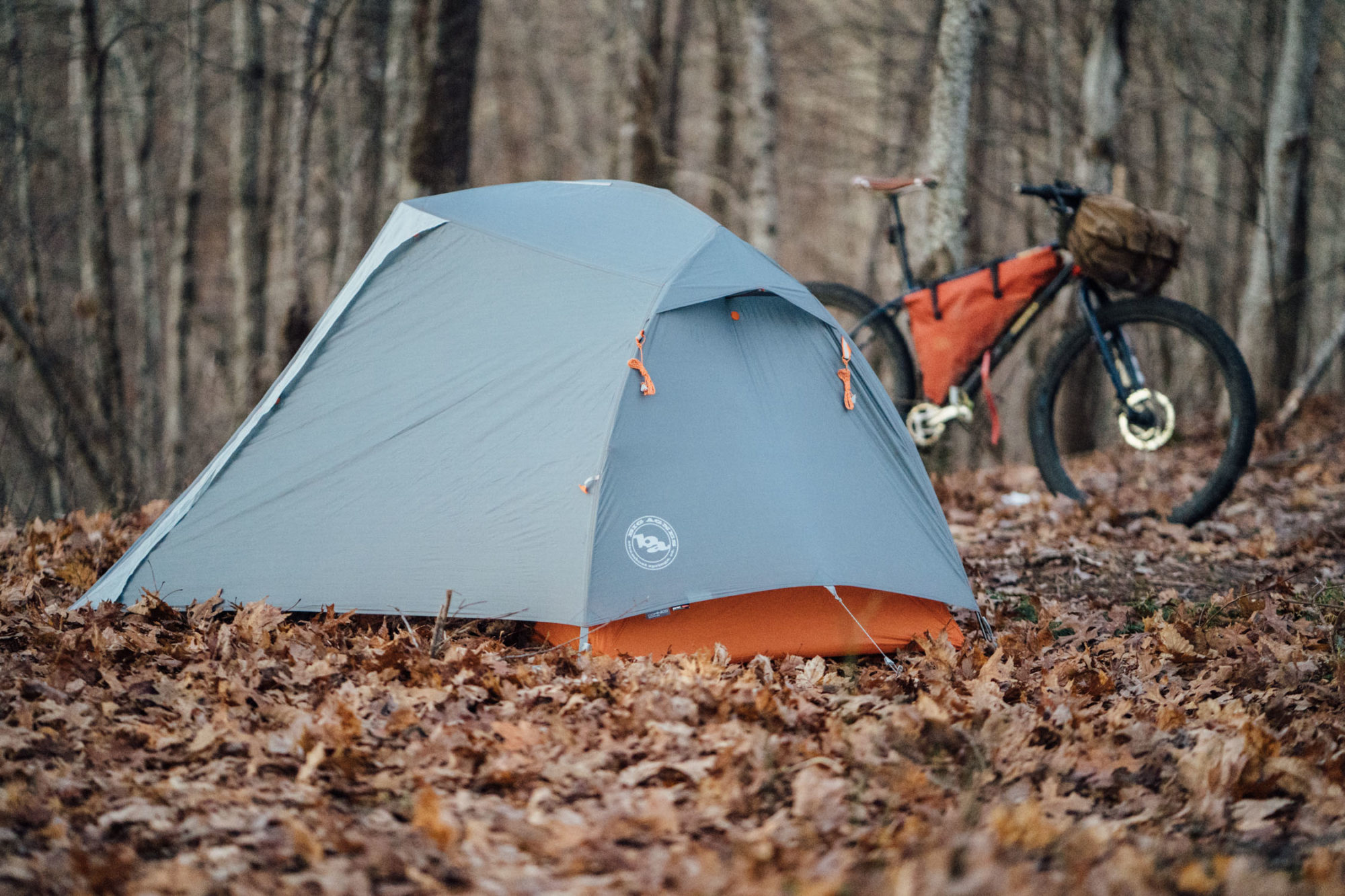
COPPER SPUR HV UL1 BIKEPACK
Copper Spur is the Big Agnes’ ultralight freestanding tent series. The crux of the Copper Spur layout is a double-sided Y pole layout–which gives it four “legs” and allows it to be a free-standing shelter. Copper Spur tents also feature a separate crossbar that adds headroom at the top of the mesh inner area. The rainfly then drapes over the inner tent body, clips at the four corners, and stakes at the middle of each side, forming a long, narrow vestibule (one on each side for 2-3p versions and one on the UL1).
The Copper Spur line has been around for the better part of a decade, seeing various improvements over the years. Actually, my first experience with Big Agnes was when we decided to purchase the original Copper Spur UL3 in 2011 to bring along on our Mexico-Central America tour after much research and deliberation. More recently, Cass reviewed the updated HV UL3 model and had good things to say.
WIth the Bikepack line, Big Agnes rolled out two bikepacking-specific versions of the Copper Spur: the HV UL1 Bikepack and Copper Spur HV UL2 Bikepack. Both Copper Spur Bikepack tents have a similar compression sack to the Fly Creek models, as well as helmet sleeves—the UL1 version has a single helmet strap at the lower part just to the left of the door.
The shortened tent poles had a bigger impact on the pack size of the Copper Spur than the Fly Creek models. For example, the current Copper Spur HV UL2 packs into a 4 x 19.5″ cylinder, while the Bikepack version of the same model packs down to 6 x 12″. Big Agnes claims the new pole design shaves a few ounces off the packed weight of the Copper Spur tents. However, it added a little weight to the Fly Creek versions. Still, as tested, the Copper Spur HV UL1 Bikepack is not as svelte as the Fly Creek model, which weighs about a half pound less and is significantly smaller when packed.
Impressions
One thing I love about the Copper Spur is that it can be quickly set up as a freestanding, un-staked mesh shelter. This is super handy when camping under a clear desert sky or under a covered area (which happens more than you’d think when traveling abroad). I also found the Copper Spur to be quite comfortable, although there’s a weight penalty for that—the result of the added crossbar pole as well as extra leg and 20 press-fit joints in the poleset. Even so, there’s a lot to like about this tent. The most significant benefit is more room for a taller rider. As mentioned, my feet sometimes get jammed against the bottom of the Fly Creek when using a thicket sleeping pad. This isn’t an issue at all with the Copper Spur. Find more thoughts in the comparison below.
Copper Spur HV UL1 Bikepack specs
- Price $399.95 (check price at REI)
- Packed Weight (as tested) 1.27 kg (2.8 pounds)
- Packed Size 5 x 13″ (11 x 33cm)
- Floor Length x Width 88 x 38-28″ (224 x 97-71cm)
- Place of Manufacture China
- Manufacturer’s Details BigAgnes.com
The Verdict on the “Bikepack” Line
We were more than stoked to hear about a line of tents created specifically for bikepacking. So much so that I was worried that it might fall short in delivering on expectations. Of all the tweaks and updates Big Agnes implemented in the Bikepack lineup, the most impressive in use are the Shortstik poles. The major benefit these shortened pole sets offer is that they can be stored in places tent poles usually can’t. For me, that often was the back of a tall frame bag. I always put heavier items in the frame bag, and when food was running low, it was nice to have the option to redistribute weight from the handlebars. In addition, the Shortstik poleset can be easily stashed into small panniers or a drop-bar-specific handlebar pack such as the BXB Teardrop, which normally can’t fit poles. They can even fit in a longer seat pack. To me, this innovation made the new Bikepack line an automatic success.
The compression stuff sack is solid addition, too. For the lightweight weekend or overnight bikepacker it makes a good entry-level handlebar pack. Ultimately, it would be nice if Big Agnes included Voile straps as well as some sort of foam spacers to push it out from the handlebars a little. But even on its own, it’s a good solution for those starting out, or for gravel bikepackers looking for a quick and easy solution for space-challenging drop bars.
As far as the other additions Big Agnes made, the 3D-Shelf and the roof daisy chain are super useful add-ons. I assume these features will eventually trickle down into their other non-Bikepack tents, although they haven’t yet. And while the helmet straps aren’t my cup of tea, I have heard others who’ve been using them and appreciate having that option.
All in all, did all of these upgrades add up to a better tent? In my opinion, yes. If I had to scrounge up a couple of quibbles, one would be that I wish big Agnes would have ditched the orange on the tent body; I’m happy they used a neutral gray on the rainfly, but I’d prefer the entire tent to be a neutral green or gray to keep it stealth. Also, it’s a shame there’s a weight increase on the Fly Creek. Again, this is mostly owed to the additional press-fittings on the pole set, but perhaps a Bikepack Platinum option could be an interesting option to further the lineup in the future?
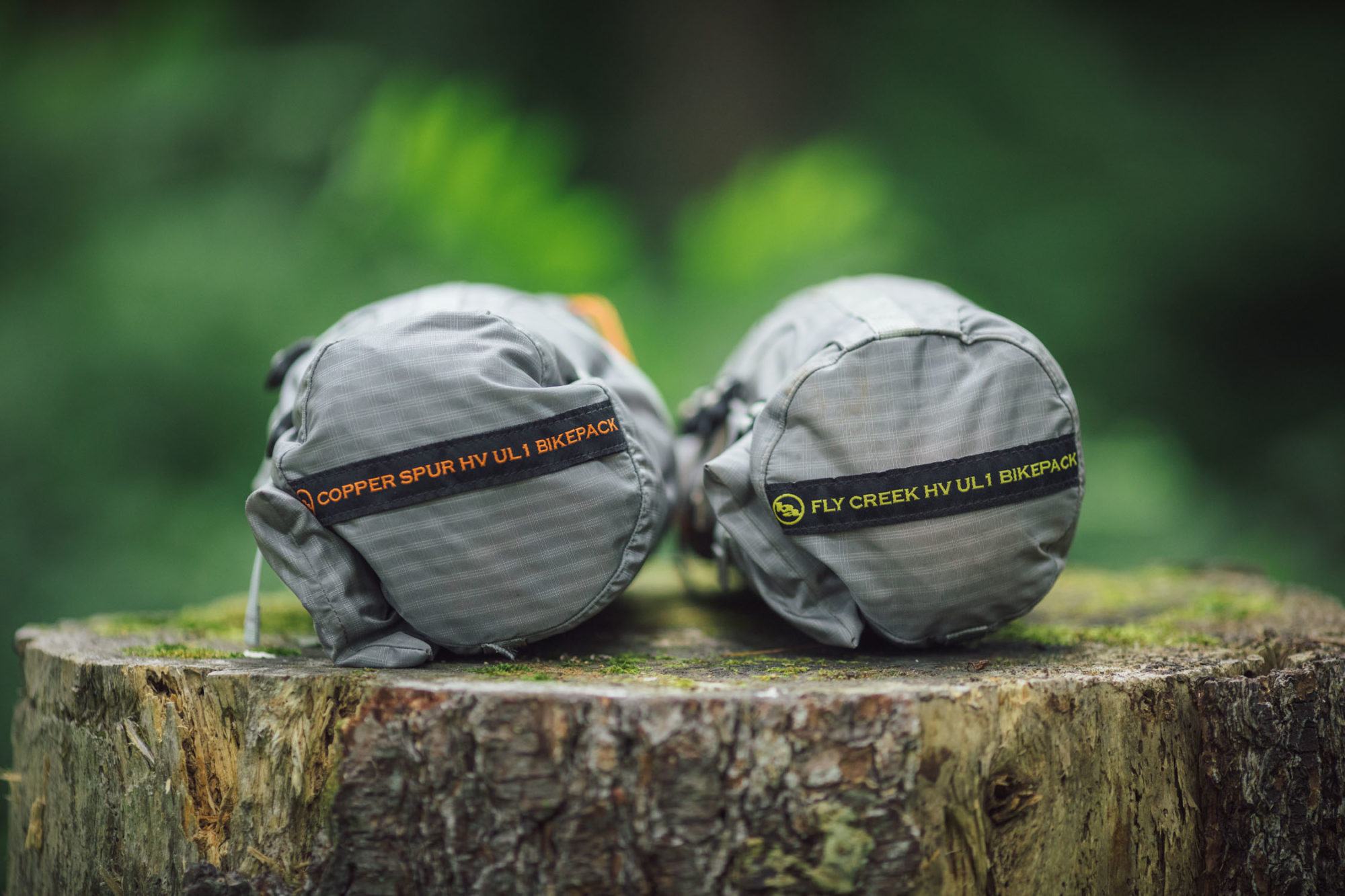
UL 1 Bikepack (Fly Creek vs Copper Spur)
Making an investment in an ultralight shelter is no joke these days. It’s hard to shell out ~400 bucks without scrutinizing and analyzing all the options. I’ve been a fan and advocate of Big Agnes tents for a while now and still think they make some of the lightest and best options for bikepacking, so I was happy to hear that they created a line specifically for two-wheeled travel.
With that said, I think both of these 1-person tents are great choices. And after using them both, I’d have a tough time picking if I could choose only one, something I thought long and hard about when writing this review. Here’s a list I put together to help narrow it down between the two:
- You prioritize lower weight over living space. Including the compression sack, the Fly Creek weighs 1.05 kg (2.3 pounds) and the Copper Spur weighs 1.27 kg (2.8 pounds); both weighed without footprint.
- You’re under 6-feet tall (or a side-sleeper). As mentioned, with a thicker sleeping pad my toes often jam against the inner wall when lying on my back. The Fly Creek’s 86” (219cm) interior floor length is only two inches shorter than the Copper Spur’s, but it’s more tapered, leaving less space in that area.
- The shortest possible tent pole set makes a difference to you. The Fly Creek set is about 11.5” (29.2 cm) while the Copper Spur poles are about 13.25” long (33.7 cm). In addition, the Copper Spur pole bundle is substantially thicker than that of the Fly Creek.
- You’re counting dollars. The Fly Creek HV UL1 Bikepack is $359, whereas the Copper Spur model is $40 more.
- You like to sit, change, play solitaire, or do anything inside the tent other than lie down. The 38” (97cm) head height of the Copper Spur is actually equal to that of the Fly Creek, but the horizontal cross-beam pole expands the area up top, making sitting and moving around quite a bit easier.
- You prefer a fully free-standing tent. This can come in handy when traveling overseas where tent camping in barns, park pavilions, covered community centers, and other such places is a common occurrence.
- You are over 6-feet tall or close to it and sleep on your back.
- You value comfort and space over size and weight.
- Ventilation is a priority; both tents breathe fairly well, but the Copper Spur has a small rainfly vent that’s a nice touch.
Please keep the conversation civil, constructive, and inclusive, or your comment will be removed.






